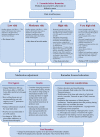Recommendations for management of diabetes during Ramadan: update 2015
- PMID: 26113983
- PMCID: PMC4477152
- DOI: 10.1136/bmjdrc-2015-000108
Recommendations for management of diabetes during Ramadan: update 2015
Abstract
Since the first ADA working group report on the recommendations for management of diabetes during Ramadan in 2005 and our update in 2010, we received many inquiries asking for regular updates on information regarding education, nutritional habits and new oral and injectable agents that may be useful for the management of patients with diabetes during Ramadan. Patients can be stratified into their risk of hypoglycemia and/or complications prior to the start of the fasting period of Ramadan. Those at high risk of hypoglycemia and with multiple diabetic complications should be advised against prolonged fasting. Even in the lower hypoglycemia risk group, adverse effects may still occur. In order to minimize adverse side effects during fasting in patients with diabetes and improve or maintain glucose control, education and discussion of glucose monitoring and treatment regimens should occur several weeks prior to Ramadan. Agents such as metformin, thiazolidinediones and dipeptidyl peptidase-4 inhibitors appear to be safe and do not need dose adjustment. Most sulfonylureas may not be used safely during Ramadan except with extreme caution; besides, older agents, such as chlorpropamide or glyburide, should not be used. Reduction of the dosage of sulfonylurea is needed depending on the degree of control prior to fasting. Misconceptions and local habits should be addressed and dealt with in any educational intervention and therapeutic planning with patients with diabetes. In this regard, efforts are still needed for controlled prospective studies in the field of efficacy and safety of the different interventions during the Ramadan Fast.
Keywords: A1C; Dietary Behavior; Education and Behavioral Interventions.
Figures
References
-
- Brown JE, Mosley M, Aldred S. Intermittent fasting: a dietary intervention for prevention of diabetes and cardiovascular disease? Br J Diab Vasc Dis 2013;13:68–72. 10.1177/1474651413486496 - DOI
Grants and funding
LinkOut - more resources
Full Text Sources
Other Literature Sources
Research Materials

